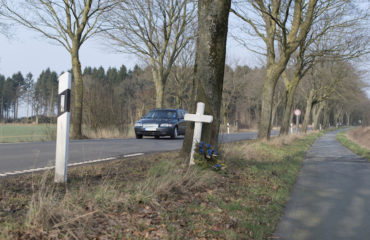How many times do we open the newspaper and read the headlines, “Drunk Driver Kills Pregnant Woman,” or turn on the TV news and hear about a person texting while driving who kills a pedestrian, or listen to the radio and hear the story about a motorcyclist killed in a single vehicle crash because he wasn’t wearing a helmet. We know these stories happen daily in communities across the United States. But interestingly enough, in the U.S. we ignore that these tragedies happen everywhere on the planet.
Decade of Action for Road Safety
Did you know:
- Around the globe 1.24 million people are killed annually in road traffic crashes.[1]
- Between 20 and 50 million people sustain non-fatal injuries annually.[2]
- More than 270,000 pedestrians lose their lives, 22% of all road fatalities. Combine motorcyclists and cyclists with pedestrians and it totals 50% of all annual road annually.[3]
- Road crashes are the leading global cause of death for young people aged 10-24.[4]
- Without action, road traffic crashes are predicted to result in the deaths of approximately 1.9 million people annually by 2020.
Recognizing the growing threat, in March 2010 the United Nations proclaimed a Decade of Action for Road Safety (2011–2020), focusing on five “pillars”: Road Safety Management; Safer Roads and Mobility; Safer Vehicles; Safer Road Users; and Post-crash Responses. The Decade, officially launched May 2011 in over 110 countries, aims to save millions of lives by enhancing the safety of roads and vehicles; altering the behavior of road users; and expanding emergency services. Countries are encouraged to implement activities based on the World Report on Road Traffic Injury Prevention, with the goal of stabilizing and then reducing the devastation caused by global traffic crashes.
The call to action by the U.N. has brought country alongside country and agency alongside agency, all focused on finding the path to safer roads, protecting citizens everywhere from the wreckage of crashes. There are promising results thus far. Eighty-eight countries reduced the number of deaths on their roads between 2007 and 2010, before the call to action even occurred. Clearly, improvements are possible. But during that same time, 87 countries saw increases in the number of fatalities. Since 2009, there has been no overall reduction in the number of people killed; however, this is in light of an increase of registered vehicles by 15%.[5] Such an increase implies some global activities had an impact when considered against the expected increase of fatalities.[6]
Everyone is Getting Involved
Governments are not the only entities working towards a decade of action of road safety. Non-Governmental Organizations (NGOs) and a variety of foundations are also focused on it. For example, The Bloomberg Philanthropies of New York partnered with a number of NGOs[7] providing grant funding of 125 million to focus on 10 countries that account for over 600,000 traffic deaths every year. The FIA Foundation, a United Kingdom charity, supports international programs promoting road safety. The Zenani Mandela Campaign is another effort to increase awareness of global pedestrian safety, launching “The Long Short Walk.”[8]
People are taking action and change is happening, but we have a very long way to go. People ask “What can I do that will make it safer for someone in Vietnam, or India or South Africa?” While the short answer is donations always help, the longer answer is the “simple” act of raising awareness can make a difference. It is time to develop an understanding of the issues, and share that knowledge with others. It is time to be an active voice of compassion, and educate family, friends and community leaders. It is time to understand that more can be done to reduce global road fatalities, the number one cause of death for people aged 10-24. As shown throughout history, one person can make a difference. Mahatma Gandhi. Dr. Martin Luther King. Nelson Mandela. Names that resonate because of the changes they made in their homelands, and beyond. While very few of us will ever rise to that national or global inspirational level, we can all be an inspiration to our family and friends. We can be leaders in our communities, share the message that lives everywhere are worth fighting for, and ensure that children everywhere can safely walk to school.
In 2010 the United Nations called for a Decade of Action; it called us to action to save lives and make a difference. Think how much can be achieved if everyone takes up the call, and acts. It is time to step up, speak out, and take action. It is time to make a difference.
[1] Global Status Report on Road Safety 2013: Supporting a Decade of Action, World Health Organization, 2013.
[2] Global Status Report on Road Safety 2013: Supporting a Decade of Action, World Health Organization, 2013.
[3] Global Status Report on Road Safety 2013: Supporting a Decade of Action, World Health Organization, 2013.
[4] Global Status Report on Road Safety 2013: Supporting a Decade of Action, World Health Organization, 2013.
[5] Global Status Report on Road Safety 2013: Supporting a Decade of Action, World Health Organization, 2013.
[6] Global Status Report on Road Safety 2013; Supporting a Decade of Action, World Health Organization.
[7] The partner organizations include Association for Safe International Travel (ASIRT), Johns Hopkins Bloomberg School of Public Health, World Bank Global Road Safety Facility, EMBARQ, and Global Road Safety Partnership.
[8] The U.S. launched the Long Short Walk on May 8 at the Jefferson Memorial.
Related articles
- Walking for Safe Roads (trafficsafetyguy.com)
- Brazil celebrates pedestrian safety for Global Road Safety Week (thecityfix.com)
- Global Road Safety Partnership South Africa in full support of the Second UN Global Road Safety Week (changeagentsforroadsafety.wordpress.com)








